Development of a Flashover Voltage Prediction Model with the Pollution and Conductivity as Factors Using the Response Surface Methodology
Abstract
:1. Introduction
2. Design Setup
3. Results and Discussion
3.1. Fits and Diagnostics
3.2. The Surface and Contour Plots
3.3. Further Confirmation of the Model
4. Conclusions
Author Contributions
Funding
Institutional Review Board Statement
Informed Consent Statement
Data Availability Statement
Conflicts of Interest
References
- Benguesmia, H.; M’ziou, N.; Boubakeur, A. Experimental study of pollution effect on the behavior of high voltage insulators under alternative current. Front. Energy 2021, 15, 213–221. [Google Scholar] [CrossRef]
- Terrab, H.; Bayadi, A. Experimental study using design of experiment of pollution layer effect on insulator performance taking into account the presence of dry bands. IEEE Trans. Dielectr. Electr. Insul. 2014, 21, 2486–2495. [Google Scholar] [CrossRef]
- Benguesmia, H.; Bakri, B.; Khadar, S.; Hamrit, F.; M’ziou, N. Experimental study of pollution and simulation on insulators using COMSOL® under AC voltage. Diagnostyka 2019, 20, 21–29. [Google Scholar] [CrossRef]
- Benguesmia, H. Modeling an Insulator Under Pollution Conditions under Alternative Voltage 50 Hz. Ph.D. Thesis, Biskra University, Biskra, Algeria, 2018. [Google Scholar]
- M’ziou, N.; Benguesmia, H.; Rahali, H. Modeling Electric Field and Potential Distribution of an Model of Insulator in Two Dimensions by the Finite Element Method. Int. J. Energetica IJECA 2018, 3, 1–5. [Google Scholar] [CrossRef]
- Benguesmia, H.; M’ziou, N.; Boubakeur, A. AC flashover: An analysis with influence of the pollution, potential and electric field distribution on high voltage insulator. In Multiphysics Modelling and Simulation for Systems Design and Monitoring; Springer International Publishing: Cham, Switzerland, 2015. [Google Scholar] [CrossRef]
- Ghermoul, O.; Benguesmia, H. Numerical simulation of potential and electric field distribution for contaminated glass insulators. In Advances in Mechanics and Energy, Proceeding of International Conference on Mechanics and Energy (ICME’2021-082), Sousse, Tunisia, 27–29 December 2021; IEEE: Piscataway, NJ, USA, 2021; p. 67. [Google Scholar]
- Benguesmia, H.; Mechta, A.E.; Ghazal, R. Numerical simulation of potential and electric field distributions on HV Insulators String. In Advances in Mechanics and Energy, Proceeding of International Conference on Mechanics and Energy (ICME’2021-150), Sousse, Tunisia, 27–29 December 2021; IEEE: Piscataway, NJ, USA, 2021; p. 74. [Google Scholar]
- Diaz-Acevedo, J.A.; Escobar, A.; Grisales-Noreña, L.F. Optimization of corona ring for 230 kV polymeric insulator based on finite element method and PSO algorithm. Electr. Power Syst. Res. 2021, 201, 107521. [Google Scholar] [CrossRef]
- Khatoon, S.; Khan, A.A.; Tariq, M.; Alamri, B.; Mihet-Popa, L. Flashover Voltage Prediction Models under Agricultural and Biological Contaminant Conditions on Insulators. Energies 2022, 15, 1297. [Google Scholar] [CrossRef]
- Hassan, E.; Nasrat, L.; Kamel, S. Experimental and Estimation of Flashover Voltage of Outdoor High Voltage Insulators with Silica Filler Based on Grey Wolf Optimizer. Int. J. Emerg. Electr. Power Syst. 2019, 20, 20190035. [Google Scholar] [CrossRef]
- Benguesmia, H.; M’ziou, N.; Boubakeur, A. Simulation of the potential and electric field distribution on high voltage insulator using the finite element method. Diagnostyka 2018, 19, 41–52. [Google Scholar] [CrossRef]
- Salem, A.A.; Abd-Rahman, R.; Rahiman, W.; Al-Gailani, S.A.; Al-Ameri, S.M.; Ishak, M.T.; Sheikh, U.U. Pollution Flashover Under Different Contamination Profiles on High Voltage Insulator: Numerical and Experiment Investigation. IEEE Access 2021, 9, 37800–37812. [Google Scholar] [CrossRef]
- Kiruthika, M.; Sivadasan, J. Evaluation and prediction of flashover voltage on contaminated composite insulators. In Proceedings of the 2015 IEEE International Conference on Electrical, Computer and Communication Technologies (ICECCT), Coimbatore, India, 5–7 March 2015; pp. 1–5. [Google Scholar] [CrossRef]
- Lin, L.; Xiaoang, L.; Tao, W.; Rui, Z.; Zhicheng, W.; Junping, Z.; Qiaogen, Z. Investigation on surface electric field distribution features related to insulator flashover in SF6 gas. IEEE Trans. Dielectr. Electr. Insul. 2019, 26, 1588–1595. [Google Scholar] [CrossRef]
- Salem, A.A.; Abd-Rahman, R. A Review of the Dynamic Modelling of Pollution Flashover on High Voltage Outdoor Insulators. J. Phys. Conf. Ser. 2018, 1049, 012019. [Google Scholar] [CrossRef]
- Salem, A.A.; Abd-Rahman, R.; Al-Gailani, S.A.; Kamarudin, M.S.; Ahmad, H.; Salam, Z. Leakage Current Components as a Diagnostic Tool to Estimate Contamination Level on High Voltage Insulators. IEEE Access 2020, 8, 92514–92528. [Google Scholar] [CrossRef]
- Venkataraman, S.; Gorur, R.S. Prediction of flashover voltage of non-ceramic insulators under contaminated conditions. IEEE Trans. Dielectr. Electr. Insulation 2006, 13, 862–869. [Google Scholar] [CrossRef]
- Dhahbi-Megriche, N.; Beroual, A.; Krähenbühl, L. A new proposal model for flashover of polluted insulators. J. Phys. D Appl. Phys. 1997, 30, 889–894. [Google Scholar] [CrossRef]
- Salem, A.A.; Rahman, R.A.; Kamarudin, M.S.; Othman, N.A. Factors and models of pollution flashover on high voltage outdoor insulators: Review. In Proceedings of the 2017 IEEE Conference on Energy Conversion (CENCON), Kuala Lumpur, Malaysia, 30–31 October 2017; pp. 241–246. [Google Scholar] [CrossRef]
- Douar, M.A.; Mekhaldi, A.; Bouzidi, M.C. Flashover Process and Frequency Analysis of the Leakage Current on Insulator Model under non-Uniform Pollution Conditions. IEEE Trans. Dielectr. Electr. Insulation 2010, 17, 1284–1297. [Google Scholar] [CrossRef]
- Gencoglu, M.T.; Uyar, M. Prediction of flashover voltage of insulators using least squares support vector machines. Expert Syst. Appl. 2009, 36, 10789–10798. [Google Scholar] [CrossRef]
- Bourek, Y.; M’Ziou, N.; Benguesmia, H. Prediction of Flashover Voltage of High-Voltage Polluted Insulator Using Artificial Intelligence. Trans. Electr. Electron. Mater. 2018, 19, 59–68. [Google Scholar] [CrossRef]
- Zhao, S.; Jiang, X.; Zhang, Z.; Hu, J.; Shu, L. Flashover Voltage Prediction of Composite Insulators Based on the Characteristics of Leakage Current. IEEE Trans. Power Deliv. 2013, 28, 1699–1708. [Google Scholar] [CrossRef]
- Cui, L.; Gorur, R.S.; Chipman, D. Evaluating flashover performance of insulators under fire fighting conditions. IEEE Trans. Dielectr. Electr. Insul. 2017, 24, 1051–1056. [Google Scholar] [CrossRef]
- Ng, K.C.; Kadirgama, K.; Ng, E.Y.K. Response surface models for CFD predictions of air diffusion performance index in a displacement ventilated office. Energy Build. 2008, 40, 774–781. [Google Scholar] [CrossRef]
- Patil, A.; Rudrapati, R.; Poonawala, N.S. Examination and prediction of process parameters for surface roughness and MRR in VMC-five axis machining of D3 steel by using RSM and MTLBO. Mater. Today Proc. 2021, 44, 2748–2753. [Google Scholar] [CrossRef]
- Venkata Rao, K.; Murthy, P.B.G.S.N. Modeling and optimization of tool vibration and surface roughness in boring of steel using RSM, ANN and SVM. J. Intell. Manuf. 2018, 29, 1533–1543. [Google Scholar] [CrossRef]
- Hasan, S.H.; Srivastava, P.; Talat, M. Biosorption of Pb(II) from water using biomass of Aeromonashydrophila: Central composite design for optimization of process variables. J. Hazard. Mater. 2009, 168, 1155–1162. [Google Scholar] [CrossRef] [PubMed]
- Muthu Krishnan, M.; Maniraj, J.; Deepak, R.; Anganan, K. Prediction of optimum welding parameters for fsw of aluminium alloys AA6063 and A319 using RSM and ANN. Mater. Today Proc. 2018, 5, 716–723. [Google Scholar] [CrossRef]

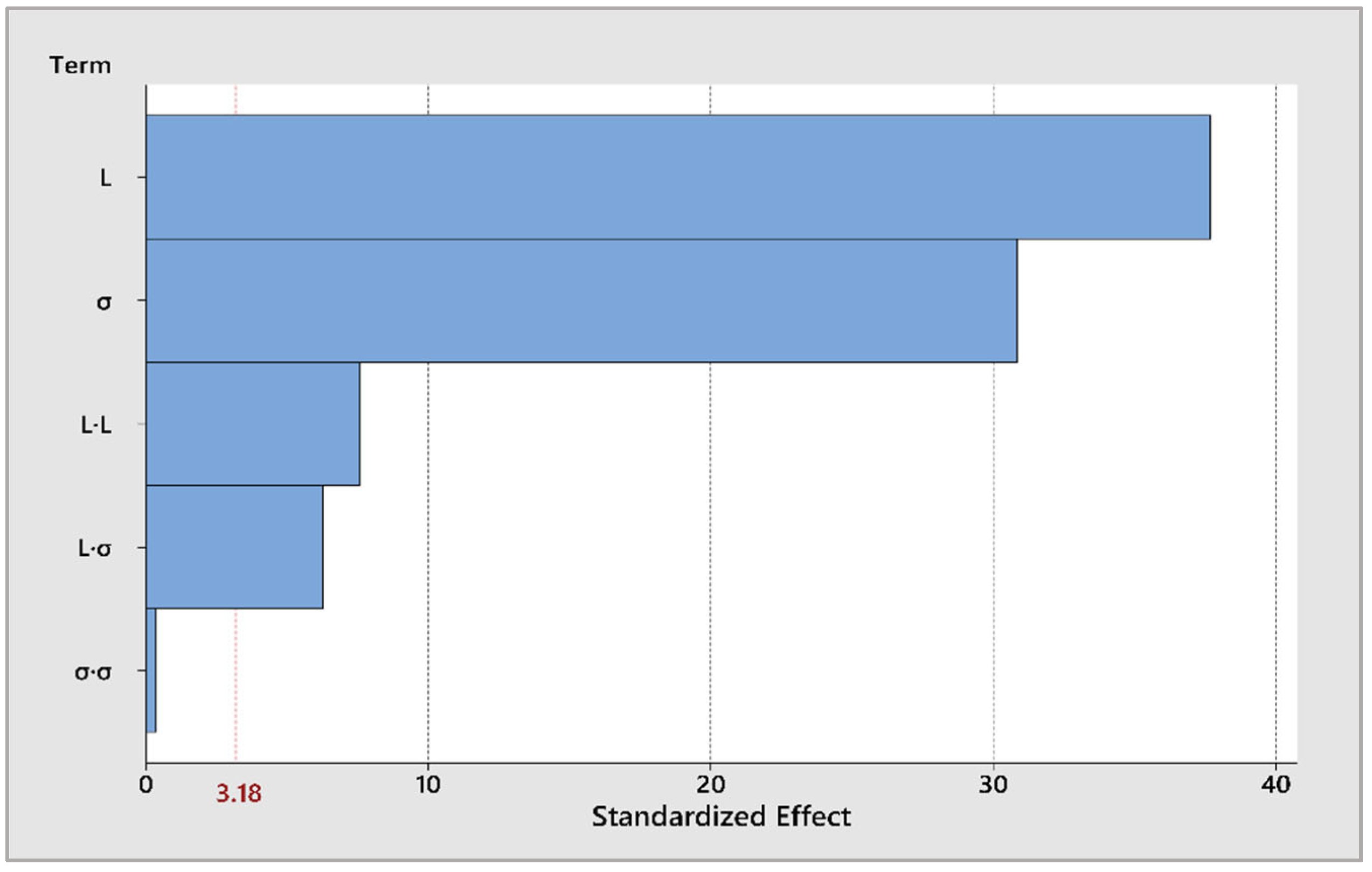
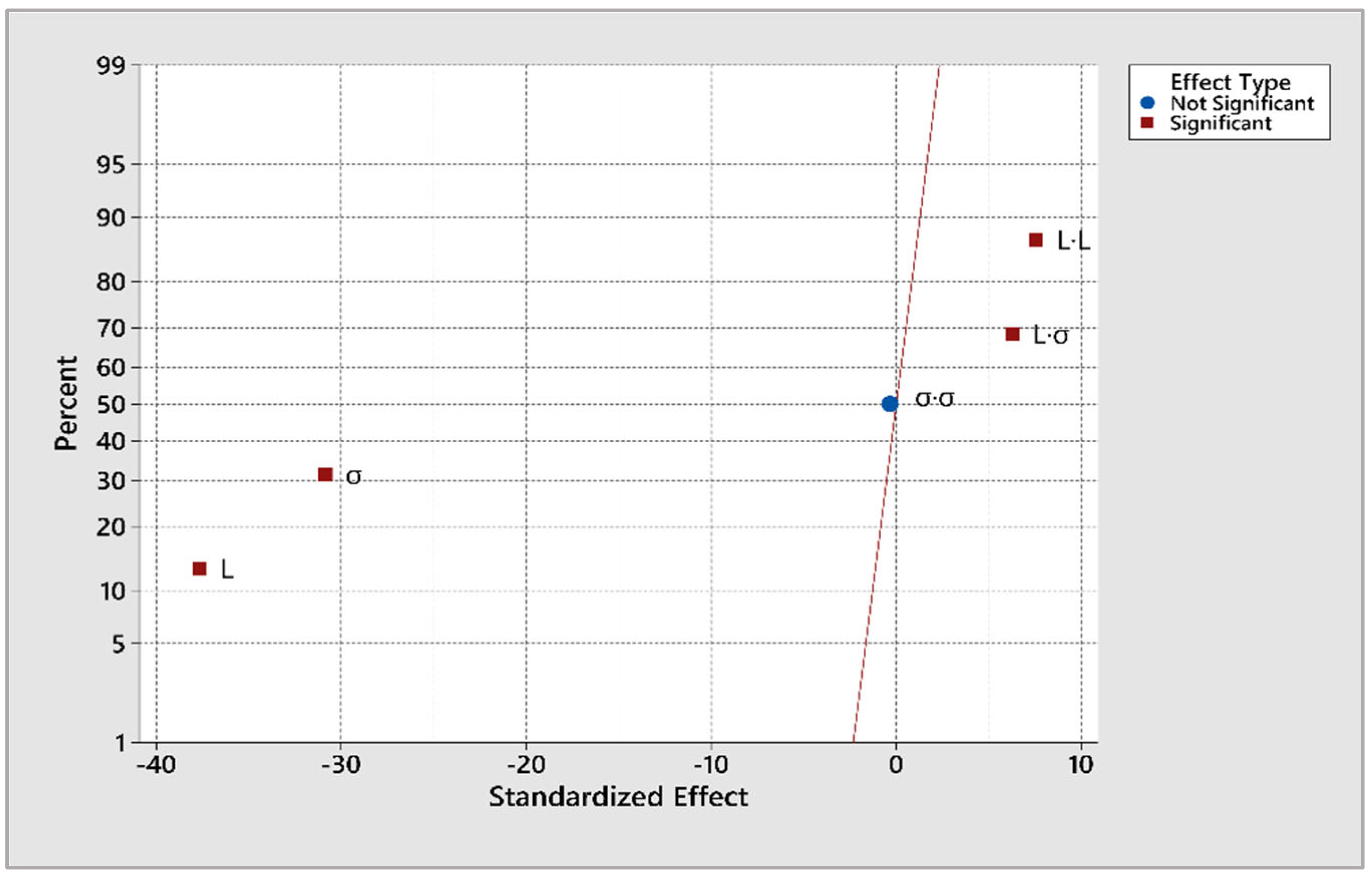

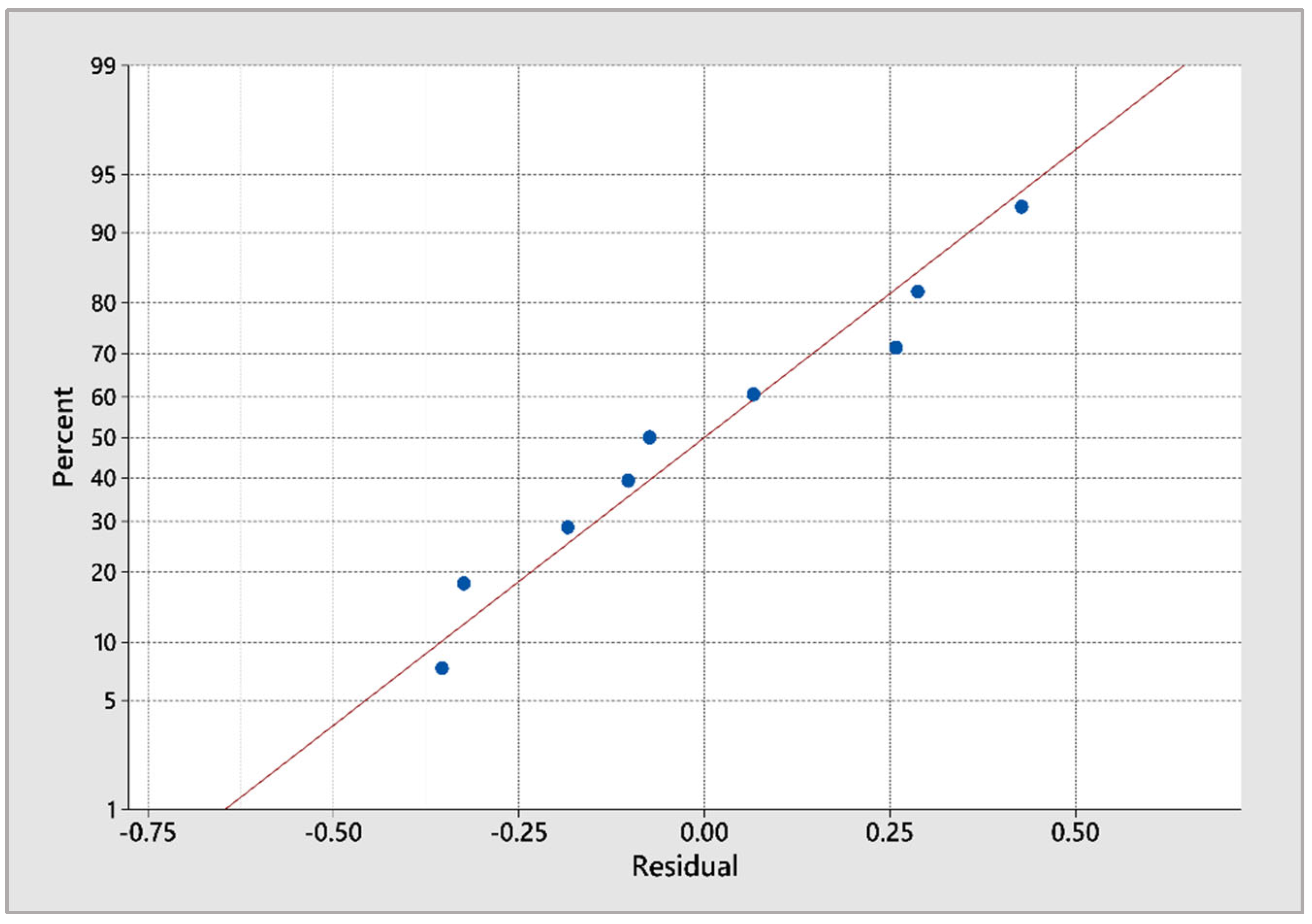

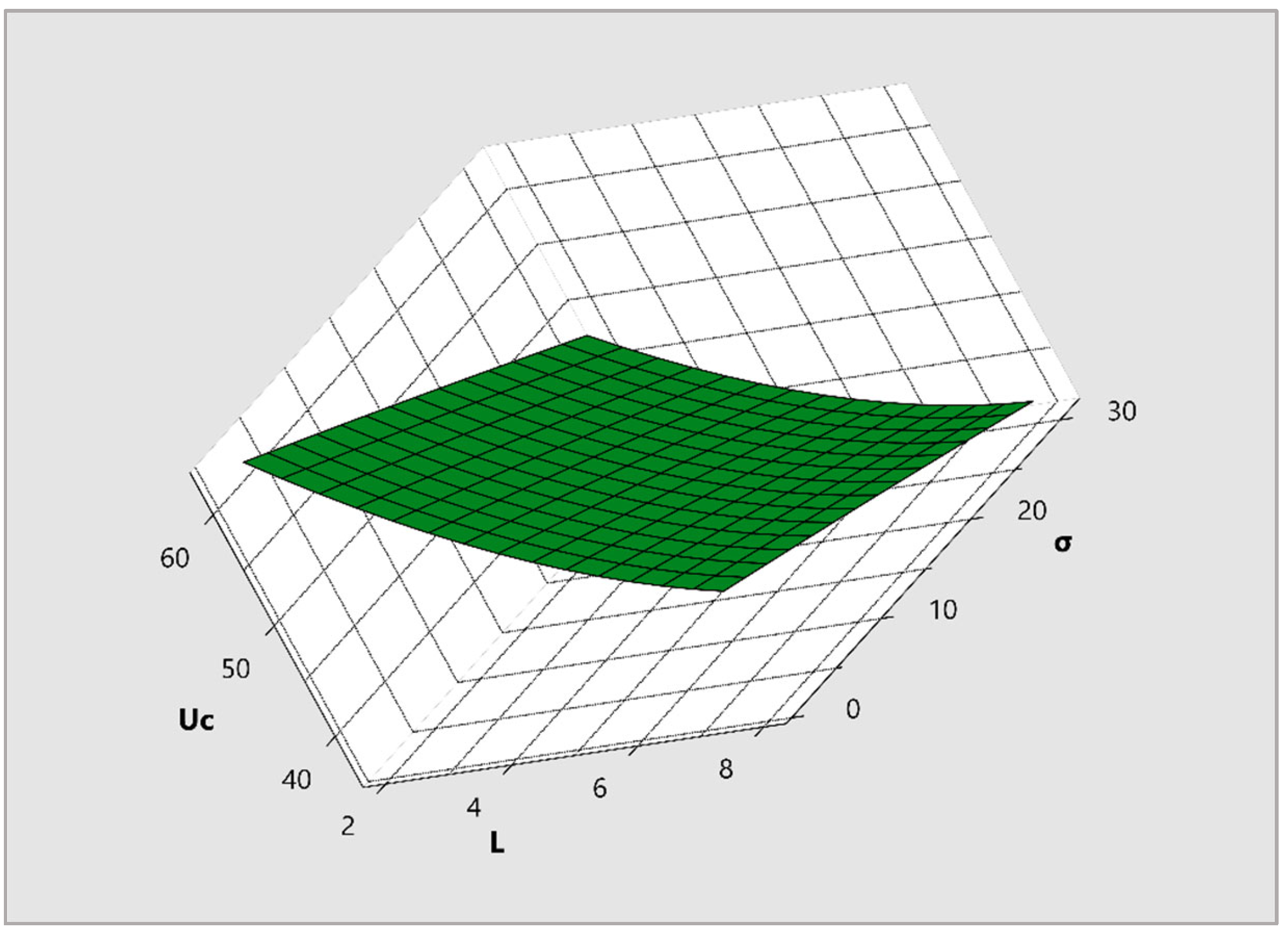
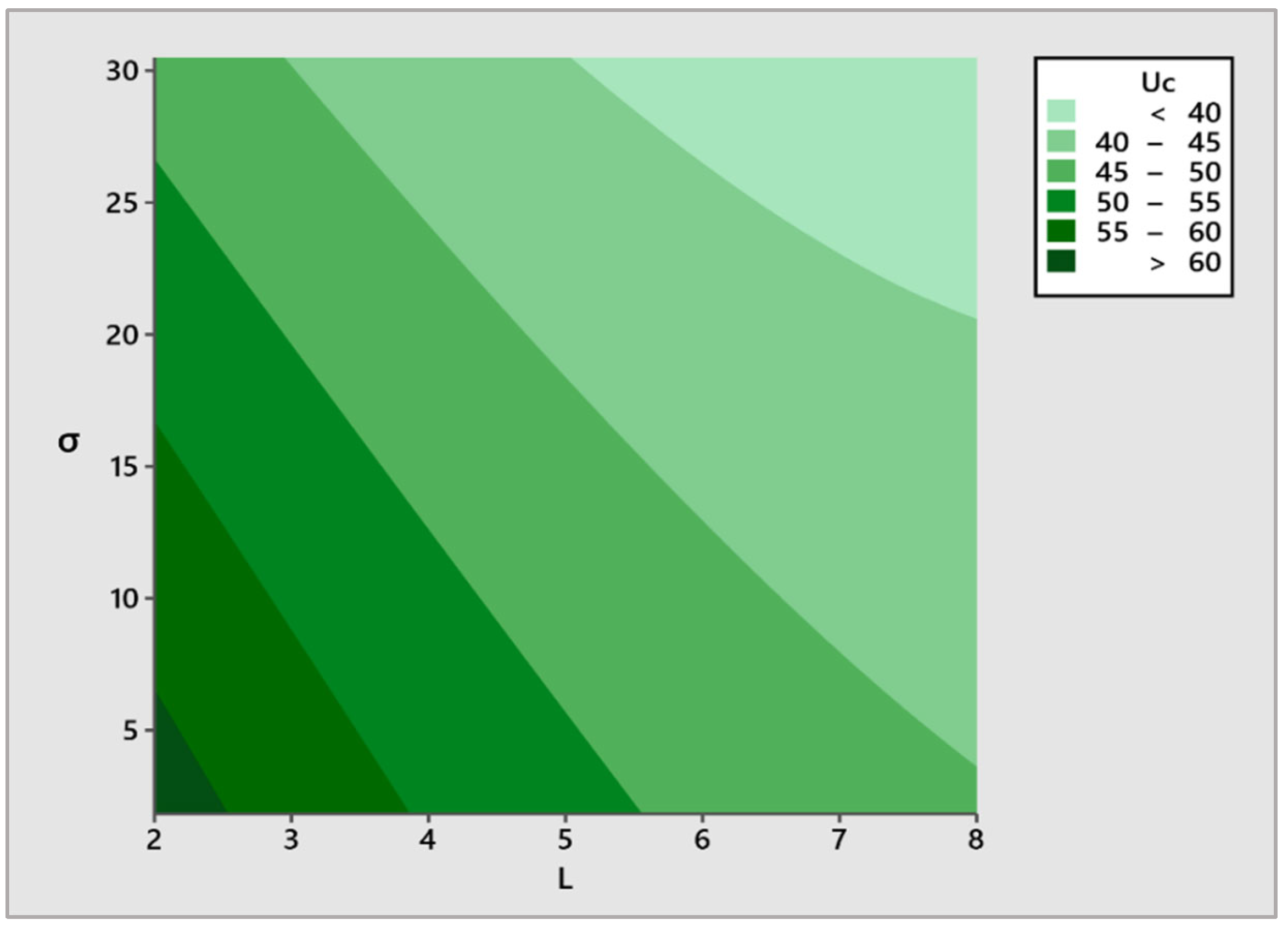
| Factors | Level of Pollution (L) | Conductivities (mS/cm) |
|---|---|---|
| Level −1 | 2 | 1.823 |
| Level 0 | 5 | 16.1615 |
| Level 1 | 8 | 30.50 |
| Number of Experiments | Level of Pollution (L) | Conductivities σ (mS/cm) | Flashover Voltage Uc (kV) |
|---|---|---|---|
| 1 | −1 | −1 | 76.6080 |
| 2 | 1 | −1 | 42.6720 |
| 3 | −1 | 1 | 76.6080 |
| 4 | 1 | 1 | 28.7000 |
| 5 | −1 | 0 | 76.6080 |
| 6 | 1 | 0 | 34.6333 |
| 7 | 0 | −1 | 50.7360 |
| 8 | 0 | 1 | 35.6000 |
| 9 | 0 | 0 | 40.9855 |
| Terms | Coefficients (Coded) | Coefficients (Uncoded) | t-Value | p-Value |
|---|---|---|---|---|
| Constant | 45.884 | 73.206 | 135.76 | 0.000 |
| L | −6.973 | −5.551 | −37.67 | 0.000 |
| σ | −5.711 | −0.5462 | −30.85 | 0.000 |
| 1.422 | −0.03306 | 7.56 | 0.008 | |
| 2.423 | 0.2693 | −0.35 | 0.005 | |
| −0.111 | 0.00054 | 6.27 | 0.753 |
| Source | Degrees of Freedom | Sums of SQUARES | Contribution % | F-Value | p-Value |
|---|---|---|---|---|---|
| Linear | 2 | 487.48 | 95.97 | 1185.49 | 0.0000 |
| Square | 2 | 11.77 | 2.32 | 28.62 | 0.0111 |
| Two-way interaction | 1 | 8.09 | 1.59 | 39.34 | 0.0082 |
| Error | 3 | 0.62 | 0.12 | // | // |
| Total | 8 | 507.950 | 100 | // | // |
| S | R2 | Adjusted R2 | Predicted R2 |
|---|---|---|---|
| 0.453433 | 99.88% | 99.68% | 98.53% |
| No | Uc (exp) (kV) | Uc (Model) (Fit) | Standard Error of Fit (SE) | 95% Confidence Interval | Residuals | |
|---|---|---|---|---|---|---|
| Lower | Higher | |||||
| 1 | 62.2 | 62.303 | 0.407 | 61.008 | 63.598 | −0.103 |
| 2 | 45.8 | 45.513 | 0.407 | 44.217 | 46.808 | 0.287 |
| 3 | 47.12 | 48.036 | 0.407 | 46.741 | 49.332 | −0.324 |
| 4 | 37 | 36.934 | 0.407 | 35.639 | 38.229 | 0.066 |
| 5 | 55.708 | 55.28 | 0.338 | 54.205 | 56.356 | 0.427 |
| 6 | 40.98 | 41.334 | 0.338 | 40.258 | 42.409 | −0.354 |
| 7 | 51.3 | 51.484 | 0.338 | 50.409 | 52.56 | −0.184 |
| 8 | 40.32 | 40.062 | 0.338 | 38.986 | 41.137 | 0.258 |
| 9 | 45.81 | 45.884 | 0.338 | 44.808 | 46.959 | −0.074 |
| Runs | Level of Pollution (L) | Conductivity σ (mS/cm) | Flashover Voltage (Numerical Model) kV | Flashover Voltage ref. [1] kV | Error (%) |
|---|---|---|---|---|---|
| 2 | 8 | 8.02 | 43.773 | 42.672 | 2.58 |
| 3 | 3 | 1.823 | 58.162 | 58 | 0.28 |
| 4 | 6 | 30.5 | 38.986 | 39.312 | −0.83 |
Publisher’s Note: MDPI stays neutral with regard to jurisdictional claims in published maps and institutional affiliations. |
© 2022 by the authors. Licensee MDPI, Basel, Switzerland. This article is an open access article distributed under the terms and conditions of the Creative Commons Attribution (CC BY) license (https://creativecommons.org/licenses/by/4.0/).
Share and Cite
Ghermoul, O.; Benguesmia, H.; Benyettou, L. Development of a Flashover Voltage Prediction Model with the Pollution and Conductivity as Factors Using the Response Surface Methodology. Energies 2022, 15, 7161. https://doi.org/10.3390/en15197161
Ghermoul O, Benguesmia H, Benyettou L. Development of a Flashover Voltage Prediction Model with the Pollution and Conductivity as Factors Using the Response Surface Methodology. Energies. 2022; 15(19):7161. https://doi.org/10.3390/en15197161
Chicago/Turabian StyleGhermoul, Oussama, Hani Benguesmia, and Loutfi Benyettou. 2022. "Development of a Flashover Voltage Prediction Model with the Pollution and Conductivity as Factors Using the Response Surface Methodology" Energies 15, no. 19: 7161. https://doi.org/10.3390/en15197161
APA StyleGhermoul, O., Benguesmia, H., & Benyettou, L. (2022). Development of a Flashover Voltage Prediction Model with the Pollution and Conductivity as Factors Using the Response Surface Methodology. Energies, 15(19), 7161. https://doi.org/10.3390/en15197161






